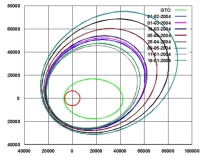No. 23 - Small Thrust Level Oscillations
The ground control engineers monitor the electric propulsion system continuously by means of telemetry parameters like discharge current and other parameters of the thrust control loop. It was reported some time ago that oscillations were observed. The engine manufacturer, SNECMA, investigated the problem and reported that although such behaviour was not considered dangerous, it was safer to avoid operating conditions where such control loop oscillations were present. To avoid these oscillations, the thruster power level was reduced to 1338W (previously at 1417W). This has a modest effect of about 200g on the fuel used, since reduced power levels imply a slightly higher Xe consumption. However, the better than expected electric propulsion efficiency and increased power availability meant that these small changes could be absorbed without mission impact.
During the last week, the flight dynamics team have measured some sudden jumps in the thrust level within a given thrust arc, of the order of 3%. Checking against ground tests, a correlation is seen between thruster anode oscillating current and thrust level, i.e. when we have high anode oscillating currents, we have lower thrust and vice versa. This information is now being regularly analysed and passed to the flight dynamics team to ease their orbit determination solutions. This shows once more the importance of the SMART-1 mission in learning how to drive a solar electric propulsion mission.
Up to 5 May, the electric propulsion system had cumulated a total ON time of about 2160 hours, consumed about 34 kg of Xenon (41% of the total propellant on board) and imparted to the spacecraft a velocity increment of about 1560 ms-1.
Orbital/Trajectory information
The osculating orbital elements are periodically computed by the ESOC specialists. These elements define the so called "osculating orbit" which would be travelled by the spacecraft if at that instant all perturbations, including EP thrust, would cease. So it is an image of the situation at that epoch. In reality the path travelled by the spacecraft is a continuous spiral leading from one orbit to another. The most recent osculating elements are as follows:
|
EPOCH (UTC) 2004/05/09 10:43:47.1 Elements WRT Earth (J2000) |
|
| Pericentre Distance (km) |
23 641.672826 |
| Apocentre Distance (km) |
98 998.745972 |
| Semi Major Axis (km) |
61 320.209399 |
| Eccentricity |
0.614455 |
| Inclination (deg) |
6.888095 |
| Asc. Node (deg) |
144.231705 |
| Arg. of Pericentre (deg) |
215.628613 |
| True Anomaly (deg) |
180.018779 |
| Osc. Orbital Period (h) |
41.977245 |
 |
In this diagram the osculating orbits at launch (GTO) and at different times are plotted. Clearly visible are the large effects that the operations of the electric propulsion have had on the orbit expansion. Especially the height of the apogee has dramatically increased and is almost reaching 100 000 km.
Since the start of the mission, the electric propulsion system has changed the orbital parameters as follows:
- The semi-major axis from 24 626 km to 61 320 km
- The perigee altitude from 656 km to 17 263 km
- The apogee altitude from 35 880 km to 92 620 km
- The orbital period from 10 hours 41 minutes to nearly 42 hours
Contact Points
Giuseppe Racca
SMART-1 Project Manager
ESA/ESTEC - SCI-PD
Keplerlaan 1- 2200 AG Noordwijk, The Netherlands
E-mail: Giuseppe.Racca esa.int
esa.int
Bernard H. Foing
SMART-1 Project Scientist
ESA/ESTEC - SCI-SR
Keplerlaan 1- 2200 AG Noordwijk, The Netherlands
E-mail: Bernard.Foing esa.int
esa.int

